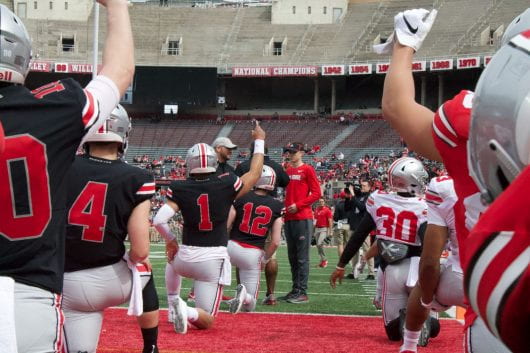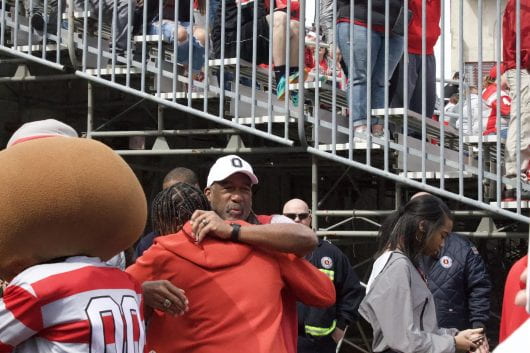
The Ohio State quarterbacks stretch before Ohio State’s Spring Game on April 13. Photo: Colin Gay | Former Sports Editor
Ryan Day needed an offensive lineman.
With the majority of his 2019 recruiting class secured prior to the February National Signing Day, the first-year Ohio State head coach had already secured a commitment from both a five-star center and a four-star offensive tackle.
But Day did not have an offensive guard in the 2019 class.
Losing four starters after the 2018 season, finding offensive line depth was on the top of Ohio State’s recruiting wish list.
Four-star offensive guard Enokk Vimahi had been on Ohio State’s radar — the Buckeyes presented an offer to him on Jan. 4 — but his recruitment was viewed as uncharted territory. He would be the first scholarship player from the state of Hawaii to ever sign with the Buckeyes.
However, without depth at offensive line, Day knew what he needed to do: He got on a plane and flew to Hawaii.
“We had to go out there and kind of uncover all the stones,” Day said. “Flying out to Hawaii, staying for three hours, getting on a redeye back to Columbus was part of that plan.”
A three-hour trip led to an official visit and a commitment on Feb. 6.
For Day, it seemed simple: He needed an offensive lineman, so he did everything in his power to get one.
But for Ohio State, it was uncharacteristic. Compared to other teams in the Big Ten conference, the Buckeyes usually do not have to spend as much to get players.
According to records obtained by The Lantern, Ohio State spent at least 28.6 percent less of its total recruiting budget on the football program compared to other Big Ten opponents during the 2018 fiscal year.
In the 2018 fiscal year, Ohio State spent 33.5 percent of its $2.8 million recruiting budget on the football program. This helped lead to the No. 3 recruiting class in the Big Ten and the No. 14 recruiting class in the country for 2019, according to 247Sports.
Ohio State spent 28.6 percent less of its overall recruiting budget on the football program compared to Michigan and 17.1 percent less than Penn State.
This level of recruiting success without the need to use as much of the budget has to do with the effectiveness of the Ohio State brand, something that is most visible on the football field.
“The brand is powerful. It’s deep. It had great breadth,” Ohio State athletic director Gene Smith said. “It’s very powerful. Just the recognition of excellence behind that brand is pretty evident in what young people see.”
It’s something St. Ignatius head football coach Chuck Kyle suspects Ohio State uses when they recruit, not only at his own school in Cleveland but schools around the country.
“There’s no reason why Ohio State should not be able to walk into anywhere and go, ‘Hey we feel you could be a great asset to our program. We’d love to have you,’” Kyle said. “I think any athlete in America would sit there and be interested.”
However, the amount spent on recruiting is not something that has to remain consistent, Smith said.
The athletic director said recruiting visits and expenses fluctuate each year depending on the state of the roster, using what he called “zero-based budgeting.”
Sometimes, programs do not need to host as many official visits during a specific recruiting period if the current roster is not expected to lose many athletes, Smith said. With this, less recruiting visits lead to less money being spent on travel costs to bring in out-of-state athletes.
But Smith does not compare Ohio State’s spending to other schools in the Big Ten.
The Lantern obtained the 2018 NCAA Financial Report from 10 of the 14 Big Ten schools. Rutgers, Northwestern, Purdue and Michigan State did not respond to this information request.
In the 2018 fiscal year, Penn State spent more than $1.3 million on football recruiting — just over half of the total recruiting budget.
With the increased amount of spending, the Nittany Lions recorded the No. 2 recruiting class in the Big Ten and the No. 13 in the country in the 2019 cycle.
Smith said comparing Ohio State’s recruiting budget to Penn State’s is like “apples and oranges.” For example, he said travel for recruiting, such as flying out of Happy Valley, could prove to be more costly for the program.
But the Penn State football program was not the highest percentage in the Big Ten.
During the 2018 fiscal year, the Michigan football program spent 62.1 percent of the athletic program’s $2.25 million overall recruiting budget.
In the 2019 class, the Wolverines had the No. 1 class in the Big Ten and the No. 8 class overall, while failing to land a five-star recruit.
Both Michigan and Penn State declined to comment for this story.
On the other hand, Ohio State has spent the third-least amount on football recruiting of the 10 programs from which The Lantern acquired data. Both Wisconsin and Indiana spent less in terms of percentage.
Iowa, Illinois, Maryland, Minnesota and Nebraska each spent a higher percentage of their total recruiting budget than the Buckeyes. However, four of those five teams finished in the bottom half of their respective divisions.
Joe Favorito, a 30-year New York-based veteran of the sports marketing, branding and public relations world, said the power of a brand in college sports is critically important and can be a factor in whether or not a program lands one of its targeted recruits.
Favorito said the Ohio State brand most likely differs from sport to sport depending on its relevance.
In football and basketball, two examples of sports that Favorito calls “elite sports,” the Ohio State brand is a preeminent entity, and one that has a great deal of recognition nationwide.
“If you talk about Johns Hopkins lacrosse, that’s a big deal in the lacrosse world. But when you talk about transcendent brands in and out of sports in the United States, Ohio State is easily top 10, if not top five, in terms of name recognition,” Favorito said.
But it is not only about the name itself. Favorito said it is about the legacy left behind by people from the past and present.
“It goes to the people and the places a lot more than just the overall brand, and you know the people that have been there and the student-athletes, the coaches, the administrators that are tied to that brand have a lot to be part of when you’re looking at a legacy brand like Ohio State,” Favorito said.
This is a legacy Urban Meyer helped create since he was hired as head coach prior to the 2012 season.
“Part of it was his brand: the Urban Meyer brand,” Smith said. “Some kids wanted to play for Urban.”

Ohio State athletic director Gene Smith hugs 2020 four-star safety and Ohio State commit Lejond Cavazos before Ohio State’s Spring Game on April 13. Photo: Colin Gay |Former Sports Editor
Smith said Meyer had a major impact on Ohio State’s recent run of recruiting success due to his tireless efforts on the trail. Meyer brought new tactics with him to Columbus, including expanding the nationwide presence that Ohio State has, by bringing more than one coach to out-of-state recruiting grounds.
From the moment he stepped onto Ohio State’s campus, Meyer set the tone in terms of the Buckeyes’ consistency in recruiting.
In the 2012 fiscal year, Ohio State spent 26.8 percent of its nearly $1.3 million total recruiting budget on the football program.
From 2012-2018, the percentage of the total recruiting budget used for the football program has not changed drastically, fluctuating within 8.4 percent in the seven-year span.
The percentage peaked in 2017, when Ohio State spent 35.2 percent of the just under $2.2 million allocated for recruiting for the football program, leading to the No. 1 2018 recruiting class in the Big Ten and the No. 2 class in the country.
Smith said there are certain things in the football budget that the program is expected to restrict, such as travel and supplies. However, he said there is no restriction for the football program when it comes to recruiting costs.
“Recruiting is our lifeblood,” Smith said. “At the end of the day, you have to be able to go out and recruit talented young people.”
Jeff Hafley likely did not know these percentages when he took the job as co-defensive coordinator and secondary coach on Day’s first coaching staff.
Hafley is seven years removed from having to recruit, spending that time in the NFL as the defensive backs coach.
But Day knew what he was getting in Hafley — his new co-defensive coordinator was the defensive backs coach with the 49ers when Day was the quarterbacks coach there in 2016. And he told the cornerbacks that Hafley would be one of the best coaches they would ever have.
Returning to the recruiting trail was not difficult for Hafley. He said recruiting is all about relationships, whether he is coaching the particular player on the field or hanging out with him off the field, talking with him or his family.
Hafley said his recruiting approach is all about how you treat people, which is the approach that Ohio State has as a program.
“The whole recruiting aspect here, this place, it’s like I said when I first met: It’s a different place now. It’s special,” Hafley said. “I don’t feel it’s very hard to recruit here right now with coach Day and the staff they have and the culture that coach [Mickey Marotti] created.”
Hafley already sensed the tradition of recruiting that preceded him. It’s a tradition that he expects from the members of the secondary, his own personal position group.
He said with the mentality of the guys in his room, it has not been hard to recruit his position group. Instead, it’s been fun.
“The cool thing is all the guys are alike. All guys are all in,” Hafley said. “Like if I bring a recruit out right here, our DBs are like, ‘Hey, you want to go hang out?’ This place is different.”
Once players leave the program, they are still a useful tool for Ohio State’s recruiting strategy, using their stories and success to build up the overall brand of the school they came from.

Ohio State 2020 five-star offensive tackle recruit Paris Johnson and 2020 four-star quarterback Jack Miller walk into Ohio Stadium prior to Ohio State’s Spring Game on April 13. Photo: Colin Gay | Former Sports Editor
“Players recruit players,” Smith said. “We got a lot of good players, and the fact that we have so many that have gone pro, that still helps us because, I don’t know, we may have two in the first round this year.”
But having the advantage in terms of recruiting is not only because of on-field success, but success in the classroom.
“I think that’s important to athletes who are looking at schools and families that are looking at schools who may not aspire to go to the NFL or the NBA,” Favorito said. “At the end of the day, it is an institute of higher learning. It’s not just a football or basketball factory.”
When talking about the academic impact of recruiting, Smith had one name come to mind: Harry Miller. Smith said academics were incredibly important to the 2019 five-star center when selecting a school, who plans to enroll in the fall as a mechanical engineering major.
Now, the Ohio State athletic director said the Buckeyes can battle to get talented players who are in the running for Ivy League-caliber schools.
“Maybe eight years ago, we would not have been able to beat Stanford,” Smith said. “Now we are recruiting against Stanford, and it’s coming down between us and Stanford, winning those recruiting battles.”
Instead of focusing on only the talent of the player, Ohio State thrives on its ability to create a well-rounded athlete, something Pat Cilento saw immediately when Ohio State came to him.
When hosting Meyer and former offensive coordinator Tom Herman, the Bullis High School head football coach had to plan ahead. With the layout of a small college — five different buildings containing classrooms — Cilento said he could not bring Meyer and Herman to the main building; instead, he snuck both around to the administrative building.
“We do that with a couple of the bigger name coaches that people will recognize again because we can’t shut down the school for 30 minutes to an hour that they’re there and then have everybody talk about it,” Cilento said. “Nothing will get done in school.”
Cilento always knew how big Ohio State was. His father, Bob Cilento, coached former Ohio State cornerback Shawn Springs at Springbrook High School in Silver Spring, Maryland, who ended up being the No. 3 pick in the 1997 NFL Draft.
Cilento said Ohio State has always been a factor in recruiting the state of Maryland, flipping Springs from Michigan on National Signing Day. However, after jumping from the Atlantic Coast Conference to the Big Ten after the 2013 season, the Buckeyes’ presence in the state has only improved.
“I would say those are the two big dogs in the state of Maryland recruiting wise,” Cilento said. “If they want somebody they’re going to get them.”
Even after former four-star quarterback Dwayne Haskins, a Bullis alum who left the Buckeyes after one of the greatest statistical seasons in school history, Ohio State was not done at the school. The Buckeyes secured a commitment from Bryson Shaw, a three-star safety in the 2019 class.
Cilento said Ohio State approaches recruiting differently than other Division I programs. He said they are one of four or five schools in the country that, “if you offer a kid, you’re pretty much going to get him.”
With that, the Ohio State coaching staff has the ability to evaluate players, spending all day with one player to see if it would be a good fit.
That is what happened with Haskins, who spent the day with former co-offensive coordinator and quarterbacks coach Tim Beck. Former co-defensive coordinator and safeties coach Alex Grinch did the same thing with Shaw.
“There are other schools without the Ohio State name so to speak. They can’t do that,” Cilento said. “I wouldn’t name a specific school, but if you’re a lesser Big Ten school and you offer that same kid, you don’t know if you’re going to get him to commit because you don’t have the backing of Ohio State.”
Even with the amount of national attention Ohio State receives, Day said in his opening press conference as head coach that the Buckeyes will continue to make in-state recruiting a major priority.

The recruiting entrance to Ohio Stadium before Ohio State’s Spring Game on April 13. Photo: Colin Gay | Former Sports Editor
But over the past seven recruiting classes, the numbers of recruits from the state of Ohio has decreased dramatically.
In the 2013 recruiting class, 10 of the 23 members were from Ohio, which accounts for 43.5 percent. This percentage peaked in the 2015 class — a class that was the highest rated in the Big Ten and No. 7 in the country — when 46.2 percent of the class came from inside state borders.
However, in the years following, that percentage has decreased dramatically. From 2016-19, 28.4 percent of the recruits acquired by Ohio State were from the state of Ohio.
As the former head coach of former Ohio State defensive tackle Dre’Mont Jones and 2019 four-star inside linebacker Tommy Eichenberg, Kyle said the Buckeyes should recruit nationally and not solely focus on in-state recruits based on the limited amount of scholarships each program has.
“[High school coaches] would love that the whole class comes from Ohio, right, and still be national champions,” Kyle said. “But come on, let’s be honest. That probably isn’t true. Let’s face it. That’s not true for any state.”
However, even if Ohio State may not take as much talent from the state, Kyle feels the Buckeyes continue to have the major advantage in recruiting its own state.
“Michigan and there’s Penn State, there’s Notre Dame, you know there’s some really top-notch programs,” Kyle said. “But I’ll say, honestly, when the kids are getting recruited by Ohio State, the other schools are kind of, ‘Oh, is Ohio State recruiting?’ It affects them a little bit.”
That is the kind of name recognition that Favorito has seen from the outside.
He said Ohio State’s ability to stand out from the pack from other schools around the country has been vital to the school’s long-term success.
“I think any kind of name recognition that makes you cut through the massive clutter where you don’t have to explain who you are or where you’re from is really important,” Favorito said. “I would be hard pressed to think of someone going at recruiting for the Ohio State University where someone would say, ‘Where is that, or who is that?’ I certainly don’t think that’s a problem that Ohio State has.”
But Smith said Day still has to make his impact in recruiting.
Following what Meyer did, with the amount of intensity he recruited, Day still has to prove he can win, Smith said. He still has to prove that the legacy of the Ohio State brand will continue through the coaching change.
And with that, Smith does not want to limit him. He said the approach for Day remains the same as it was under Meyer: “We need to go wherever they are.”
However, the Ohio State athletic director does have one stipulation.
“If someone is trying to go to Hawaii every year,” Smith said, “we have a problem.”





